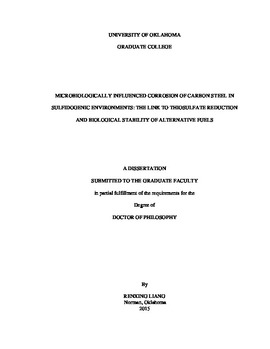| dc.description.abstract | Biocorrosion or microbiologically influenced corrosion (MIC) refers to the mutiple underlying mechanisms wherein microbial activity directly or indirectly enhances the corrosion of metallic and non-metallic materials. Biocorrosion associated with metallic materials (e.g., carbon steel) is notoriously known for causing costly damage in both the upstream and downstream energy infrastructure, often with catastrophic environmental consequences. While numerous mechanisms are known or have been proposed for this long-standing problem, a thorough fundamental understanding of biocorrosion is still lacking and therefore no panacea exists for the diagnosis and treatment of this complicated process. The first two chapters of this dissertation focus on the biocorrosion of carbon steel in upstream operations by the dominant thiosulfate reducing bacteria (TRB) cultivated from hot oil pipelines or from high salinity produced water after the hydraulic fracturing of shale formations. The last two chapters deal with an assessment of the biological stability of second-generation and next-generation biofuels and their impact on corrosion of carbon steel in the downstream fueling infrastructure.
It is well recognized that microorganisms can corrode metallic surfaces under diverse conditions with a combination of different electron donors and acceptors. Historically, the importance of sulfate-reducing bacteria (SRB) in biocorrosion processes has been well documented, but it is entirely possible that other important groups of microorganisms also play crucial roles in catalyzing this activity.
We found that TRB were more numerically abundant than SRB in a “PIG” sample from a hot oil pipeline on Alaska’s North Slope. The thiosulfate-reducing and methanogenic enrichments cultivated from this sample were dominated by thermophiles from the genus of Anaerobaculum. The corrosion assay indicated that sulfidogenesis coupled to the thiosulfate-reducing enrichment was more aggressive in exacerbating the corrosion of carbon steel relative to the methanogenic enrichment. This work highlighted the importance of fermentative, thiosulfate-reducing bacteria in the corrosion of oil pipelines under thermophilic conditions. In contrast, methanogenic processes coupled to either complex organic matter metabolism or the metal itself was far less important in catalyzing the corrosion of carbon steel.
An exploration of the microbial ecology of highly saline produced water systems from a hydraulic fractured shale gas production facility was also carried out. A molecular survey revealed that the microbial community of this produced water system was predominated by halophilic bacteria affiliated with the genus Halanaerobium. We further hypothesized that these organisms played important roles in carbon and sulfur cycling in the fractured shale formations and contributed to corrosion through sulfide and acid production. One of the dominant microorganisms (Halanaerobium sp., strain DL-01) was isolated and found to degrade guar gum, the major gelling agent in the fracture fluid and produce acetate and sulfide when thiosulfate was served as a terminal electron acceptor. A corrosion scenario in this hydraulically fractured site was tentatively proposed based on the metabolic capacity of Halanaerobium sp. DL-01 and the well-known corrosivity of acetate and sulfide in oil and gas industry. This work mainly implicated that sulfide and acetate produced by fermentative, thiosulfate-reducing halophiles in the deep fractured subsurface may contribute to corrosion in the downstream gas pipelines and storage.
Apart from the conventional corrosion problems associated with upstream energy facilities in the oil and gas industry, the increasing global interest in the adoption of alternative fuels raised new issues about the compatibility of emerging biofuels with the existing carbon-steel infrastructure. A protocol was developed to comprehensively assess the biological stability of fuels and applied to the study of second-generation biofuels (camelina-JP5 and FT-F76). That is, the biodegradability of the fuels as well as their potential to exacerbate carbon steel biocorrosion was assessed using three coastal seawaters as starting inocula. The highest sulfate reduction rates were always associated with camelina-JP5, a finding that suggested that this hydroprocessed fuel might be more susceptible to biodegradation relative to other fuels. Metabolite profiling attested to the anaerobic metabolism of n-alkanes and alkylbenzenes in the fuel. The relatively strong linear correlation between sulfate reduction and corrosion (both general and pitting corrosion) suggested that biogenic sulfide production linked to anaerobic metabolism of fuel constitutes can largely account for the increased biocorrosion in marine environments. An important implication of this work was that caution should be exerted with the use of hydroprocessed camelina-JP5 during long term storage due to its relative liability.
While numerous efforts are still underway toward the development of second generation alternative fuels, next generation biofuels such as terpene dimer fuel (TDF) have recently been synthesized. This fuel was designed to meet the demand for a high-density biofuel that might be used in conjunction with petroleum fuels. It was hypothesized that TDF might resist anaerobic biodegradation due to the dimerization and hydrogenation of the parent substrates. Using the same protocol, it was found that TDF was relatively recalcitrant and had negligible influence on corrosion over an extended incubation period. These results suggest that this synthetic biofuel might be safe with respect to corrosion of carbon steel but may raise environmental concerns due to its relative persistence under anaerobic conditions should it ever be spilled. Given the well-recognized importance of surface inclusions as sites for pit initiation, the relationship between the manganese dissolution from the metal and pitting corrosion in TDF-laden environments was investigated. The low manganese (Mn)/weight loss value differentially associated with coupons exhibiting a greater degree of pitting corrosion substantiated the hypothesis that this ratio is potentially useful as an indicator of this important corrosion process. | en_US |
